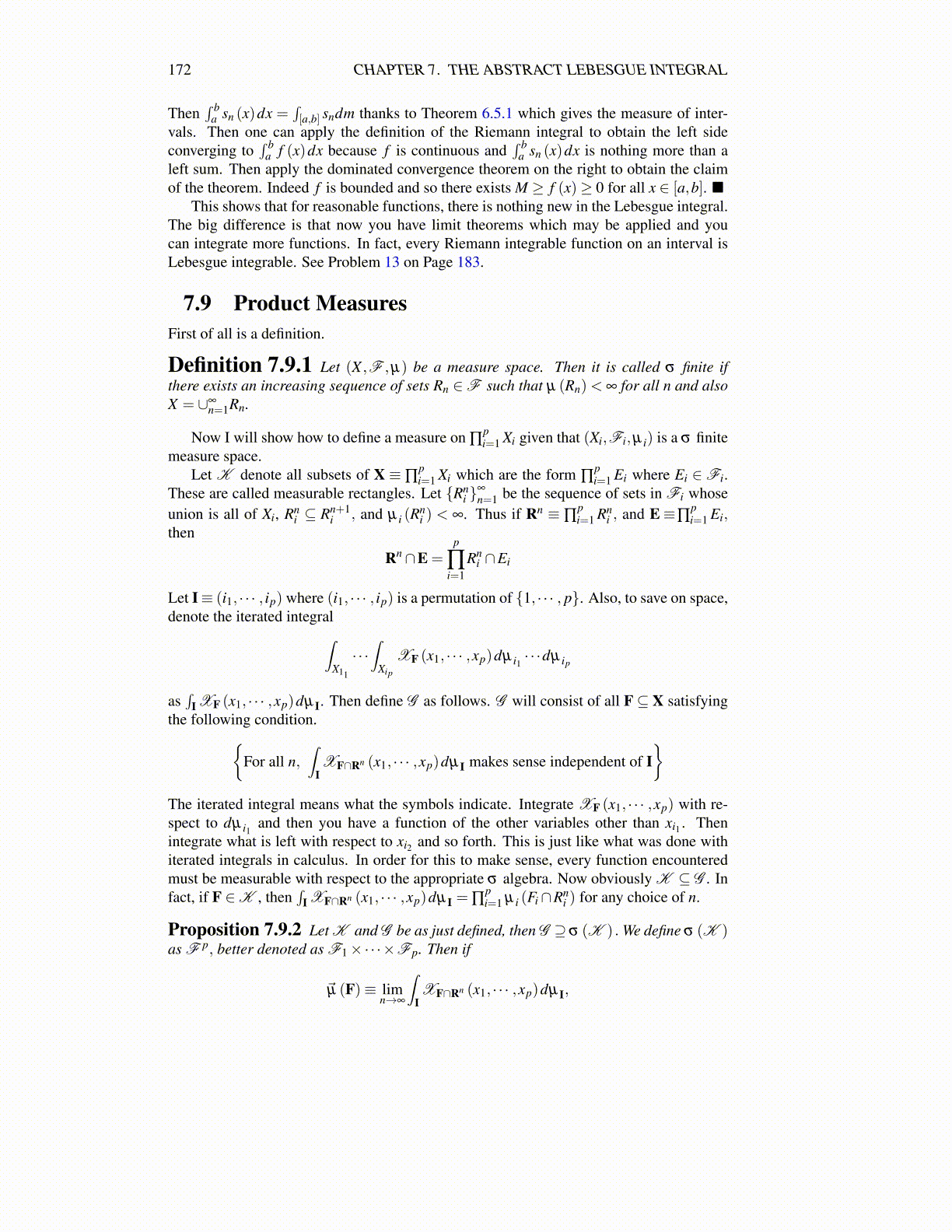
172 CHAPTER 7. THE ABSTRACT LEBESGUE INTEGRAL
Then∫ b
a sn (x)dx =∫[a,b] sndm thanks to Theorem 6.5.1 which gives the measure of inter-
vals. Then one can apply the definition of the Riemann integral to obtain the left sideconverging to
∫ ba f (x)dx because f is continuous and
∫ ba sn (x)dx is nothing more than a
left sum. Then apply the dominated convergence theorem on the right to obtain the claimof the theorem. Indeed f is bounded and so there exists M ≥ f (x)≥ 0 for all x ∈ [a,b]. ■
This shows that for reasonable functions, there is nothing new in the Lebesgue integral.The big difference is that now you have limit theorems which may be applied and youcan integrate more functions. In fact, every Riemann integrable function on an interval isLebesgue integrable. See Problem 13 on Page 183.
7.9 Product MeasuresFirst of all is a definition.
Definition 7.9.1 Let (X ,F ,µ) be a measure space. Then it is called σ finite ifthere exists an increasing sequence of sets Rn ∈F such that µ (Rn)< ∞ for all n and alsoX = ∪∞
n=1Rn.
Now I will show how to define a measure on ∏pi=1 Xi given that (Xi,Fi,µ i) is a σ finite
measure space.Let K denote all subsets of X ≡ ∏
pi=1 Xi which are the form ∏
pi=1 Ei where Ei ∈Fi.
These are called measurable rectangles. Let {Rni }
∞
n=1 be the sequence of sets in Fi whoseunion is all of Xi, Rn
i ⊆ Rn+1i , and µ i (R
ni ) < ∞. Thus if Rn ≡ ∏
pi=1 Rn
i , and E≡∏pi=1 Ei,
then
Rn∩E =p
∏i=1
Rni ∩Ei
Let I≡ (i1, · · · , ip) where (i1, · · · , ip) is a permutation of {1, · · · , p}. Also, to save on space,denote the iterated integral∫
X11
· · ·∫
Xip
XF (x1, · · · ,xp)dµ i1 · · ·dµ ip
as∫
I XF (x1, · · · ,xp)dµI. Then define G as follows. G will consist of all F⊆ X satisfyingthe following condition.{
For all n,∫
IXF∩Rn (x1, · · · ,xp)dµI makes sense independent of I
}The iterated integral means what the symbols indicate. Integrate XF (x1, · · · ,xp) with re-spect to dµ i1 and then you have a function of the other variables other than xi1 . Thenintegrate what is left with respect to xi2 and so forth. This is just like what was done withiterated integrals in calculus. In order for this to make sense, every function encounteredmust be measurable with respect to the appropriate σ algebra. Now obviously K ⊆ G . Infact, if F ∈K , then
∫I XF∩Rn (x1, · · · ,xp)dµI = ∏
pi=1 µ i (Fi∩Rn
i ) for any choice of n.
Proposition 7.9.2 Let K and G be as just defined, then G ⊇ σ (K ) . We define σ (K )as F p, better denoted as F1×·· ·×Fp. Then if
µ⃗ (F)≡ limn→∞
∫IXF∩Rn (x1, · · · ,xp)dµI,